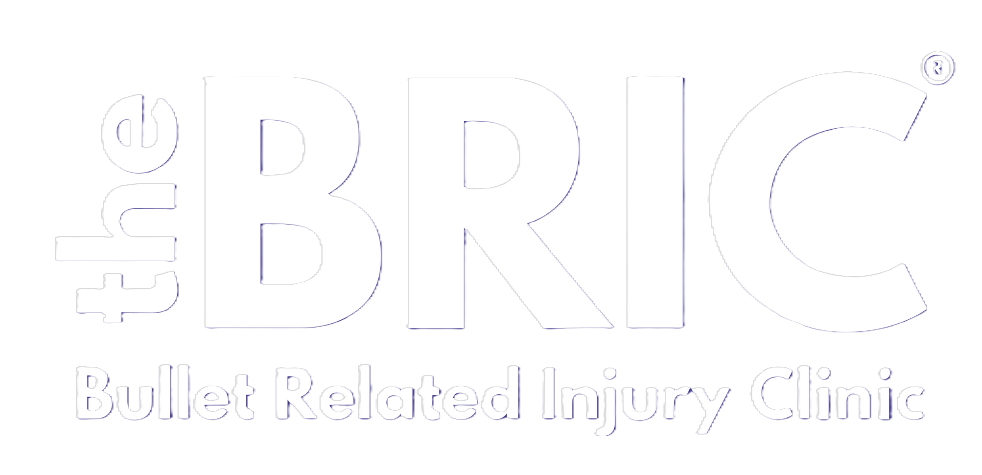Retained Bullets
Retained bullets, and fragments greater than ¼ inch or 3mm are of great concern for patients. They can be lodged in the dermis, under the skin, inside muscle bellies, in bone, and in deep organs such as being embedded in the liver or spinal canal.
For these, it is essential to disclose to the patient what is retained and where it is retained. Often patients are given inaccurate guidance about their bullets such as:
-
Bullets can be left in without harm
-
Bullets don’t move
-
Bullets don’t create any additional symptoms when retained
-
“This isn’t the movies”
There is little to no evidence that retained bullets are without risk. There is mounting evidence that they are associated with depression, higher rates of repeat injury, and when embedded in bone and organ spaces, can be sources of systemic lead poisoning. At The BRIC, we have observed a pattern of “localized lead toxicity” in which both symptoms of myopathy and neuropathic pain are greatly exacerbated. Patients with retained bullets also complain bitterly of cold intolerance and express substantial psychic distress about what the ongoing presence of the bullet means. For this reason, it is imperative to disclose to the patient where their bullet is and what their options are.

1. Skin
For fragments and bullets embedded in the skin, they are likely to be extruded from the body through a process of inflammation, pus formation, and skin rupture not unlike a splinter. This process can be avoided through elective removal through a minor procedure. Risks and benefits are standard as is all minor skin only surgery with pre-medication using injected lidocaine. For those who desire extraction, it is appropriate to provide an early option to do so. Often foreign bodies retained in the skin represent additional projectiles such a as glass. There is potentially some benefit in waiting for overlaying inflammation, bruising, and edema in the tissue to resolve before doing a superficial bullet removal, however, those benefits are lost with the risk of ongoing distress at the presence of the bullet.
2. Fat
Subcutaneous bullets that are palpable can also be easily removed through a minor procedure using local anesthesia. The BRIC has observed that subcutaneous bullets are the highest risk for infection, especially when they are near the feet and/or groin. In this case, if immediate extraction is not planned, a course of antibiotics should be considered. As early as possible is suggested for all palpable subcutaneous bullets. If they are not palpable, point of care bedside ultrasound can be performed to assess depth. Bullets 2cm deep or less are able to be removed with a minor bedside procedure using local anesthesia as well, provided ultrasound guidance has been used to mark location before beginning the procedure. Subcutaneous bullets at are deeper than 4cm and not in the muscle may migrate to the surface over time, thus a plan for repeat ultrasound monthly is appropriate for the first 3 - 6 months of an acute BRI.
3. Muscle
Intramuscular bullets can be very close to the surface but do pose a higher risk of bleeding and pain. It is important to use ultrasound to confirm location. In these circumstances, patients are very high risk for localized lead toxicity as well as cold intolerance and muscle spasm. If the bullet is greater than 2cm deep, a minor procedure is not possible to perform for removal. Plan should be made for a more complex procedure with sedation. In the interim, patients should be treated for myopathy, neuropatic pain, and spasm as previously stated. Monthly ultrasounds for the first 3-6 months should be offered for appropriate surveillance,switching to 2-4 times per year or with change in symptoms.
4. Bone
The pain of retained bullets in the bone is severe. It is also associated with much higher risk of lead toxicity. For these patients, it is important to screen lead lead levels at baseline and every 3-6 months, adding natural chelation therapy with chlorella and ginger, and escalating if levels rise above 5. Blood lead screens should be available at the point of care. There appears to be a spike in symptoms related to deep retained bullets at 2 years. Patients should be prepared and counseled on how to recognize the symptoms and what options for care they have.
5. Body
Deep retained bullets, for instance in the liver or spinal canal, may have a profound role in creating systemic lead toxicity. For these patients, surveillance and even IV chelation is necessary.
